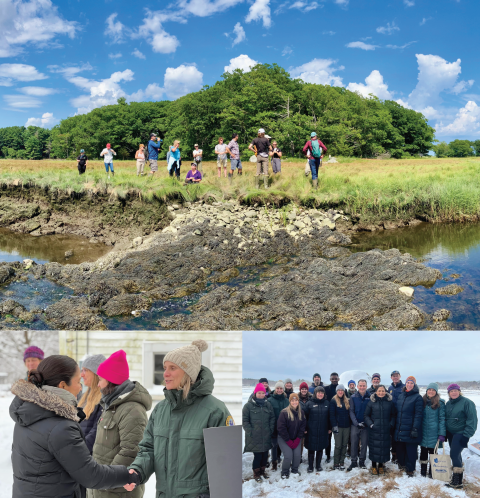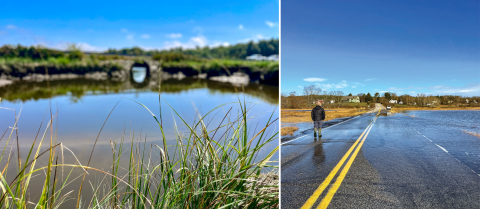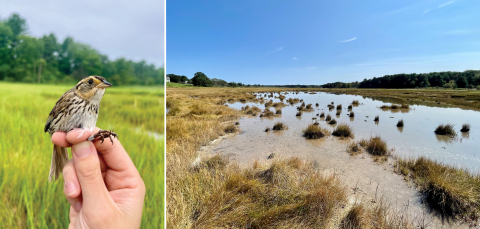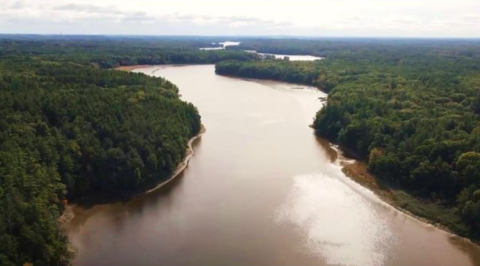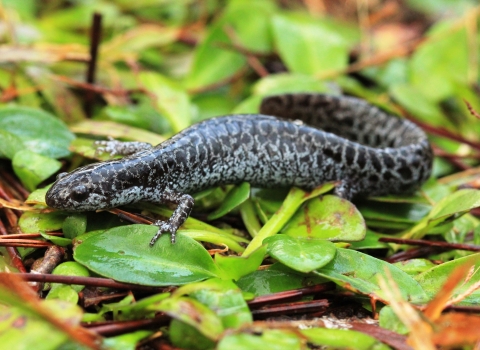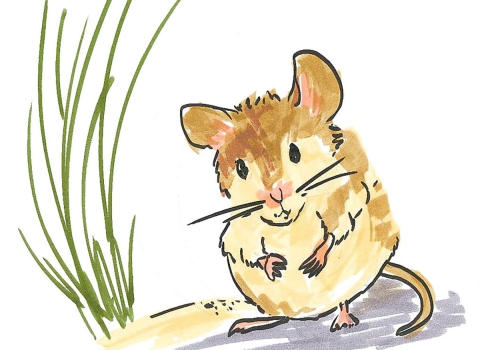In 2024, the U.S. Fish and Wildlife Service Gulf of Maine Coastal Program (GOMCP) made significant strides in restoring and protecting habitats across Maine and New Hampshire. Through strong partnerships and collaboration, we’ve expanded our impact and brought our expertise to communities. From improving stream flow in western Maine to restoring coastal marshes, our efforts support wildlife and engage the public in conservation. Here are some key accomplishments and ongoing projects making a difference in our region.
Restoring the Kennebago River watershed: protecting wildlife and communities in western Maine
The Kennebago River watershed is one of the best places in the United States to support brook trout as our climate changes. By replacing old, undersized culverts with sturdy, open-bottom bridges, this project not only saves money in the long run but also helps reconnect important cold-water habitats that fish and other aquatic organisms need to survive as temperatures rise. These improvements make our human infrastructure—like roads and bridges—better able to handle extreme weather while also benefiting wildlife and supporting our local economy, which relies on healthy forests and outdoor recreation.
Rangeley Lakes Heritage Trust (RLHT) received $1 million of Congressionally Directed Spending administered through GOMCP to lead this important project. As of 2024, five barriers were replaced with new bridges designed to handle major storms, restoring more than eight miles of vital cold-water streams. Additionally, two miles of stream received in-stream habitat improvements through the addition of strategically placed wood, which helps create deeper pools, increases floodplain stability and connectivity and supports the base of the aquatic food chain.
The project includes a full watershed assessment, giving RLHT the tools to continue protecting this important area in the future. Native species like wild brook trout and wood turtles, along with other aquatic life, are already benefiting from these efforts, thanks to the teamwork and expertise of GOMCP staff in planning, survey and design, permitting and construction oversight. To explore this project further, visit RLHT's website and check out the StoryMap.
Restoring New Hampshire salt marshes through an America the Beautiful Challenge award
Salt marshes along New Hampshire’s coast are valuable ecosystems that provide vital habitats for a variety of migratory birds, diadromous fish, wetland plants and other wildlife. They also protect our communities by reducing flooding, absorbing wave energy and stabilizing shorelines. However, centuries of human activity like farming, mosquito ditching, development and the spread of invasive species invasive species
An invasive species is any plant or animal that has spread or been introduced into a new area where they are, or could, cause harm to the environment, economy, or human, animal, or plant health. Their unwelcome presence can destroy ecosystems and cost millions of dollars.
Learn more about invasive species have damaged these vital wetlands.
In January 2024, U.S. Secretary of the Interior Deb Haaland visited a salt marsh salt marsh
Salt marshes are found in tidal areas near the coast, where freshwater mixes with saltwater.
Learn more about salt marsh in Rye, New Hampshire, along with other officials, to highlight the importance of restoring these ecosystems. During the visit, a $2 million America the Beautiful Challenge award was presented to the New Hampshire Department of Environmental Services – Coastal Program (NHCP) and its partners. This funding will support a range of projects to restore 239 acres of tidal wetlands across New Hampshire. These projects will use innovative techniques like creating small drainage channels (called runnels) and repairing historical farming and mosquito control ditches to restore marsh health. This work will also help save critical habitats for the saltmarsh sparrow, a bird species at risk of extinction. Specific projects include:
- Hampton ditch remediation project: Repairing old ditches to create more vegetated marsh and reconnect fragmented areas, improving the marsh’s condition and resilience.
- Philbrook Pond single channel hydrology project: Improving drainage in a highly degraded marsh with large bare patches and working with 13 nearby private landowners.
- Fairhill Marsh and Odiorne Point adaptive management project: Removing old farming barriers, improving tidal flow, controlling invasive plants, creating habitat and establishing long-term monitoring to support marsh health.
GOMCP is providing essential support for these efforts, including project planning, surveying, mapping and restoration design. NHCP will also bring together the New Hampshire Salt Marsh Task Force to coordinate with stakeholders and ensure the long-term health of these marshes.
These restoration projects highlight how federal investments are helping protect and restore New Hampshire’s valuable coastal wetlands. Through teamwork and innovation, we’re ensuring these salt marshes can thrive for both wildlife and people.
Working together to restore salt marshes in Maine
In Maine, an increasing number of partners are collaborating to restore salt marshes by securing funding for projects that improve marsh health, enhance wildlife habitats and boost coastal resilience. A key salt marsh restoration project is underway at Spurwink Marsh in Cape Elizabeth. GOMCP is working with local partners, including the Wells National Estuarine Research Reserve, the towns of Cape Elizabeth and Scarborough, the Rachel Carson National Wildlife Refuge and the Casco Bay Estuary Partnership. A major issue at Spurwink Marsh is that Sawyer Road, along with its undersized culvert, divides the marsh and often floods during storms, creating significant safety risks for the community. Additionally, old farming practices have significantly disrupted the natural flow of tidal water on the marsh.
In the fall of 2023, the Town of Cape Elizabeth was awarded $1.5 million from the Maine Natural Resources Conservation Program and the National Fish and Wildlife Foundation’s Coastal Resilience Fund. This funding will support road removal and other changes to improve tidal flow and enhance habitat in the marsh. GOMCP has played an important role in this restoration effort by helping assess the site, monitoring water levels, creating maps and gathering data to support the project. GOMCP will also assist with project planning, restoration design, permitting, implementation and effectiveness monitoring.
Similar restoration projects are happening all along Maine’s coast, with many groups working together. To make these efforts even more effective, a coordinated effort was needed. With support from GOMCP staff, the Maine Tidal Marsh Restoration Network held its first meeting in the spring of 2024, bringing together more than 50 key stakeholders from federal, state, local, nonprofit and university groups. The network identified eight key areas to focus on, including increasing project funding, creating a statewide restoration plan, improving permitting, developing better monitoring methods and coordinating with other community resilience efforts. GOMCP looks forward to continuing its support in organizing the Maine Tidal Marsh Restoration Network and assisting with efforts to advance restoration projects that improve marsh health and strengthen coastal resilience.
Protecting habitat in the Gulf of Maine watershed
Protecting and restoring the Gulf of Maine’s lands and waters is vital for wildlife and community health. With climate change climate change
Climate change includes both global warming driven by human-induced emissions of greenhouse gases and the resulting large-scale shifts in weather patterns. Though there have been previous periods of climatic change, since the mid-20th century humans have had an unprecedented impact on Earth's climate system and caused change on a global scale.
Learn more about climate change and development threatening natural areas, preserving these spaces is vital to maintain biodiversity, support recreation and strengthen community resilience to storms and flooding.
GOMCP collaborates with federal, state and nonprofit partners to protect key habitats in the Gulf of Maine watershed. In 2024, we supported projects securing more than $5.3 million in funding, plus $10.5 million in matching funds, by providing technical expertise like mapping and data analysis. Partners involved in these projects include:
- Blue Hill Heritage Trust
- Brunswick Topsham Land Trust
- Coastal Rivers Conservation Trust
- Forest Society of Maine
- Great Works Regional Land Trust
- Maine Coast Heritage Trust
- Maine Department of Inland Fisheries and Wildlife
- Northeast Wilderness Trust
- Pleasant River Wildlife Foundation
- Scarborough Land Trust
- Rachel Carson National Wildlife Refuge
Western Foothills Land Trust
These efforts will protect more than 8,380 acres of wetlands, forests and marshes, vital for species like the American black duck, Atlantic salmon, piping plover and monarch butterfly. Safeguarding these habitats ensures a thriving future for wildlife and people in the Gulf of Maine.




